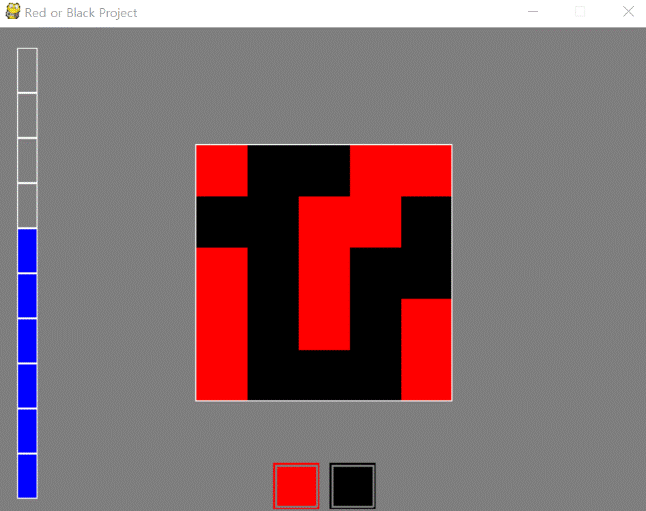Actually, everything doesn’t seem like a game. Now, we will insert a rule into this program. Then. It will become game. Rule is simple: counting red or black from 5x5 2D array and choose the color which has much more number! If correct, HP++, otherwise, HP--. Then new array will be set for next quiz! too simple but game which can be made in this tutorial. First, we need to generate 2D array and print it. How? We learned how to print integer data (which equals single data (0D array)) and two buttons (which equals single array (1D array). Case of 2D array just needs one-more step.

1import sys, pygame
2pygame.init()
3
4size = width, height = 320, 240
5speed = [2, 2]
6black = 0, 0, 0
7
8screen = pygame.display.set_mode(size)
9
10ball = pygame.image.load("AdvancedOutputAlpha1.webp")
11ballrect = ball.get_rect()
12
13while True:
14 for event in pygame.event.get():
15 if event.type == pygame.QUIT: sys.exit()
16
17 ballrect = ballrect.move(speed)
18 if ballrect.left < 0 or ballrect.right > width:
19 speed[0] = -speed[0]
20 if ballrect.top < 0 or ballrect.bottom > height:
21 speed[1] = -speed[1]
22
23 screen.fill(black)
24 screen.blit(ball, ballrect)
25 pygame.display.flip()

1import sys, pygame
2pygame.init()
3
4size = width, height = 320, 240
5speed = [2, 2]
6black = 0, 0, 0
7
8screen = pygame.display.set_mode(size)
9
10ball = pygame.image.load("AdvancedOutputAlpha2.webp")
11ballrect = ball.get_rect()
12
13while True:
14 for event in pygame.event.get():
15 if event.type == pygame.QUIT: sys.exit()
16
17 ballrect = ballrect.move(speed)
18 if ballrect.left < 0 or ballrect.right > width:
19 speed[0] = -speed[0]
20 if ballrect.top < 0 or ballrect.bottom > height:
21 speed[1] = -speed[1]
22
23 screen.fill(black)
24 screen.blit(ball, ballrect)
25 pygame.display.flip()

1import sys, pygame
2pygame.init()
3
4size = width, height = 320, 240
5speed = [2, 2]
6black = 0, 0, 0
7
8screen = pygame.display.set_mode(size)
9
10ball = pygame.image.load("AdvancedOutputAlpha3.webp")
11ballrect = ball.get_rect()
12
13while True:
14 for event in pygame.event.get():
15 if event.type == pygame.QUIT: sys.exit()
16
17 ballrect = ballrect.move(speed)
18 if ballrect.left < 0 or ballrect.right > width:
19 speed[0] = -speed[0]
20 if ballrect.top < 0 or ballrect.bottom > height:
21 speed[1] = -speed[1]
22
23 screen.fill(black)
24 screen.blit(ball, ballrect)
25 pygame.display.flip()
generateboard function returns randomly generated 2D board with the number of red block and black block. Needless to explain. Also, printboard function prints 2D board by same method as 1D array. Output color will be changed by data of board[i][j] is 1 or not. This board is for output only. Processing about margin seems to be annoying because we have to know exact location by calculating. Remember prolog. Output (executing result) of Pygame is GUI but input(coding) of Pygame is CUI. That is Pygame.
Actually, there are a lot of idea for improving this game. How about changing button into image file? How about adding sound effect when previous chose was correct or not? How about setting time limit? How about adding visual effect when player win(maxHP) or not(minHP)? How about make the board bigger with another colors? How about implement Flood-it game by given interface? There are still lots of selection because this game is simple.
<Reference Code>
import pygame, sys, random
from pygame.locals import*
maxHP = 10
white = (255,255,255)
gray = (127,127,127)
black = (0,0,0)
red = (255,0,0)
green = (0,255,0)
blue = (0,0,255)
pygame.init()
pygame.display.set_caption("Red or Black Project")
width = 640
height = 480
myScreen = pygame.display.set_mode((width, height))
myTextFont = pygame.font.Font("HoonWhitecatR.ttf", 32)
myText = myTextFont.render((str(maxHP) + "/" + str(maxHP)), True, red, gray)
myTextArea = myText.get_rect()
myTextArea.center = (width/2, height/2)
fpsClock = pygame.time.Clock()
def main():
HP = 5
board, b_red, b_black = generateBoard(5,5) #1
while True:
myText = myTextFont.render((str(HP) + "/" + str(maxHP)), True, red, gray)
myScreen.fill(gray)
myScreen.blit(myText, myTextArea)
drawHP(HP)
drawButtons()
drawBoard(board) #2
for event in pygame.event.get():
if event.type == QUIT:
pygame.quit()
sys.exit()
elif event.type == KEYDOWN:
if event.key == K_UP:
if HP != 10:
HP = HP + 1
elif event.key == K_DOWN:
if HP != 0:
HP = HP - 1
elif event.type == MOUSEBUTTONUP:
x, y = event.pos
if pygame.Rect(270, 425, 45, 45).collidepoint(x, y): #3
if b_red >= b_black:
if HP != 10:
HP = HP + 1
board, b_red, b_black = generateBoard(5,5)
elif b_red < b_black:
if HP != 0:
HP = HP - 1
board, b_red, b_black = generateBoard(5,5)
elif pygame.Rect(325, 425, 45, 45).collidepoint(x, y): #4
if b_red <= b_black:
if HP != 10:
HP = HP + 1
board, b_red, b_black = generateBoard(5,5)
elif b_red > b_black:
if HP != 0:
HP = HP - 1
board, b_red, b_black = generateBoard(5,5)
pygame.display.update()
fpsClock.tick(60)
def drawHP(HP):
r = int((height - 40) / maxHP)
pygame.draw.rect(myScreen, gray, (20, 20, 20, 20 + ((maxHP - 0.5) * r)))
for i in range(maxHP):
if HP >= (maxHP - i):
pygame.draw.rect(myScreen, blue, (20, 20 + (i * r), 20, r))
pygame.draw.rect(myScreen, white, (20, 20 + (i * r), 20, r), 1)
return
def drawButtons():
r = 45
r_margin = 10
colors = [red, black]
num = 2
margin = int((width - ((r * num) + (r_margin * (num - 1)))) / 2)
for i in range(0, num):
left = margin + (i * r) + (i * r_margin)
up = height - r - 10
pygame.draw.rect(myScreen, colors[i], (left, up, r, r))
pygame.draw.rect(myScreen, gray, (left + 2, up + 2, r - 4, r - 4), 2)
def generateBoard(width, height): #5
board = []
b_red = 0
b_black = 0
for x in range(width):
column = []
for y in range(height):
column.append(random.randint(0, 1))
board.append(column)
for x in range(width):
for y in range(height):
if(board[x][y] == 1):
b_red = b_red + 1
elif(board[x][y] == 0):
b_black = b_black + 1
return board, b_red, b_black
def drawBoard(board): #6
r = 50
b_width = 5
b_height = 5
l_margin = int((width - (b_width * r)) / 2)
u_margin = int((height - (b_height * r)) / 2)
for x in range(5):
for y in range(5):
left = x * r + l_margin
up = y * r + u_margin
if board[x][y] == 1:
color = red;
elif board[x][y] == 0:
color = black
pygame.draw.rect(myScreen, color, (left, up, r, r))
left = l_margin
up = u_margin
pygame.draw.rect(myScreen, white, (left-1, up-1, r * 5 + 1, r * b_height + 1), 1)
if __name__ == '__main__':
main()
Edit on GitHub
